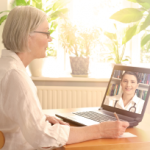(Reuters Health)—Patients who have real-time video visits with their primary care providers instead of in-person exams are generally satisfied with the convenience and quality of their checkups, a new study suggests.
There’s a lot about these telemedicine visits that can sound appealing: no need to get stuck in traffic on the way to the doctor; no long stretches in the waiting room before the exam; no missing half a day of work for an appointment that’s over in the blink of an eye. But, to date, research hasn’t offered a clear picture of how the reality of virtual visits matches up with patients’ expectations
“Prior to the current study, there was very little research evidence about primary-care video visits, especially when the visits are with a patient’s own primary care providers (the ones they also visit in-person) as a part of their ongoing clinical care,” says lead study author Mary Reed, DrPH, of Kaiser Permanente Northern California.
Dr. Reed and colleagues surveyed 1,274 patients at Kaiser in Northern California who had a scheduled video visit with a primary care provider in autumn 2015 to see how well the technology and the medical care worked for them.
Nearly all of the participants had some previous experience using video calling, although it may have been for personal or professional meetings and not for a medical checkup. Most of them also had undergraduate or advanced degrees and more than a third had household income of more than $100,000 a year.
Patients who had to take time off from work or other responsibilities for an in-person visit reported more often that the video visit reduced their in-person visits.
As reported April 29 online in Annals of Internal Medicine, there were many reasons patients cited for having video visits: 87% found it more convenient; 82% liked that they could have the video visit with their regular primary care provider; and 70% were not sure they needed to go see a doctor in person.1
After the video exams, 93% of patients felt the checkup met their needs; 92% felt the provider was familiar with their medical history; and 90% were confident in the quality of their care.
Additionally, 84% of patients who had video visits thought the experience improved their relationship with their provider.
However, 41% of participants said they preferred an in-person visit, 24% expressed concern about making their home or video visit space presentable for the checkup, and 21% of patients worried they might not get adequate treatment.



